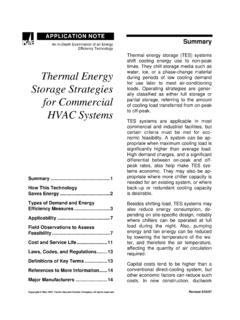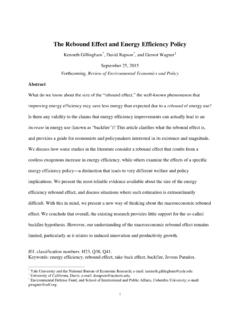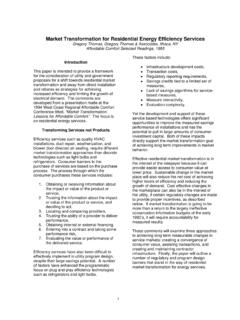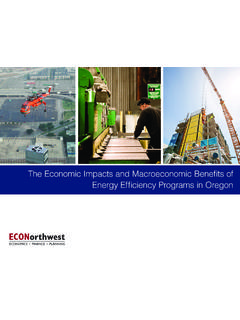Transcription of Energy Efficiency Services Sector - Pacific Gas and ...
1 Energy Efficiency Services Sector : Workforce Size Expectations for GrowthWorkforce Size, Expectations for Growth, and Training NeedsJane S. PetersResearch Into Action, 14, 2010 EEffi iEnergy Efficiency Services Sector Workforce Size:Current and projected levels of employment in PYEKey Insights & ChallengesyggFor Workforce Growth4 Difficulty Hiring?Difficulty Hiring?Respondents report challenges hiring into the EESS for ANY position other than entry level Managers and engineers with experience in Energy Efficiency ANY position other than entry eegye cecyespecially difficult to find Filling experienced positions often occurs by hiring fromoften occurs by hiring from other firms Labor union respondents also preport some difficulty recruiting qualified applicants into apprenticeship programsDifficulty in hiring for the 8 Efficiency -specific occupations in Engineers?Enough Engineers?The most likely source for new EESS engineers is to transition engineers from other fields into Energy Efficiency But until Energy engineering is Few engineers enter the field ith EEifrom other fields into Energy Efficiency .
2 But until Energy engineering is recognized as an engineering discipline this may be EE experience The demand for engineers with knowledge of Efficiency is currently met by hiring other types of engineers and training them on the job Many industries compete for engineering talent, and engineers often do not know the EESS field e istsPreferred Engineers for Program Administrators the EESS field exists and Implementation ContractorsEnough Managers?Enough Managers?30% of survey respondents indicated that it is as difficult to find The primary limitation onexperienced EE managers as engineering talent. The primary limitation on implementation contractor firm growth (or expanded program offerings for some gadministrators) is the lack of management-level applicants with EE experience Experienced managers are vital mentors for the next generation of managersgeneration of managersRdf G th?Ready for Growth?Relatively low level of awareness in the building and construction industry about the potential for growth in the EESS Program Administrators estimated that their staff will 19% b 2010yp ggrow ~19% by 2010 Implementation Contractors estimated that their staff will grow ~64% by 2010 In contrast, less than 50% of 160 respondents that representedrespondents that represented building and construction industry associations and trades could even estimate the percent of the current workforce that was involved in EEworkforce that was involved in EEThe influence of Energy Efficiency on the building Workforce?
3 Aging Workforce?Retirement is not currently a concern for program administrators or implementation contractors; however the building and constructionimplementation contractors; however, the building and construction industry is facing substantial changes in the workforce due to retirements between 2015 and 2025 Pt f t ff lik l ttiiPercent of staff likely to retire in next 5 years: Program Administrators Minor issue for some (~15%)() Implementation Contractors & Program Support Contractors Not an issue (~5%)ESCOsNot an issue ( 5%) ESCOs Not an issue (~5%) Building and Construction Industry Growing concern (>35%)g()Building Industry Workforce Older than 50 SfKChllSummary of Key Challenges Shortage of managementlevel Shortage of management-level applicants with experience in Energy Efficiency Shortage of experienced Energy Efficiency engineersBuilding and construction industry: Building and construction industry: limited awareness that the EESS is poised to expand significantly and their skills will be requiredrequired Retirement is a growing concern limited number of skilled trainers for EEEESS Workforce Training & gEducational Requirements11 Target EE Training for the TradesTarget EE Training for the Trades Building and construction tradesBuilding and construction trades constitute about 65-70% of the overall workforce in the EESS, and there is a notable lack of awareness that the EESS is poised for significant growth Problem appears more severe in states that do not have long-running ratepayer-funded programs It will be important, especially in states that are ramping up Energy Efficiency , to integrate building and industrial process system Efficiency into existing curricula Increase Short-Duration Applied TrainingsIncrease ShortDuration.
4 Applied Trainings to Augment On-the-Job Training Much of the growth in the EESS will come from new entrants who already have some applicable skills ( contractors who become Efficiency retrofit specialists) Strong demand for uptodate training for those who are currently Strong demand for up-to-date training for those who are currently employed in the EESS but who need to update or augment their skills Mid-and senior-level engineers and managers also need moreMidand seniorlevel engineers and managers also need more access to conferences and training, such as those offered by the AESP and the Certified Energy Manager certificate program offered by the AEE Short-duration courses on specific, applied EE-related topics will be more relevant than a 2 or 4-year degree program for BOTH professionals and tradespeoplePrepare the Next Generation ofPrepare the Next Generation of EESS Professionals Few colleges offer EE-specific curriculum, and those that do say funding to grow these programs is extremely limited Funding is needed to support new and expanded EE-related programs Industrial Assessment Centers have been a successful model to provide Energy efficiencysuccessful model to provide Energy Efficiency Services to industry and a training ground for engineering students Similar centers could be developed in conjunction with college-based engineering architecture planning and policyfocused programsengineering, architecture, planning.
5 And policy-focused programs Building science centers for architecture and engineering students Policy centers that emphasize education needed for EE program design and project implementationIFdit TithIncrease Funding to Train the Trainers There is likely to be a lack of qualified trainers to train the workforce to support the projected EESS growth WAP network estimates they will need 700 additional trainers by summer 2010 to meet their goals Many community colleges rely on a small group of key instructors to teach courses, and many are nearing retirement ageage BPI experienced 5-fold increase in number of certifications between 2005 and 2008, and believe the number will almost triple between 2008 and 2009 p Growth rates strain the capacity of existing trainers Additional resources must be directed towards training the next generation of EESS trainersCoordinate Training EffortsCoordinate Training Efforts Coordinate and track training efforts within states; share best practices across statesstates; share best practices across states With ARRA funding, many states are initiating and/or ramping up a range ofinitiating and/or ramping up a range of training activities that target the EESS Still challenging to identify those programsStill challenging to identify those programs that will provide specific EESS education.
6 This information needs to be tracked in a systematic way Establishing broad statewide education/training efforts ( , NYSERDA s collaboration with Hudson Valley Community College) may be helpful to avoid duplication of effortsContactJane S. PetersResearch Into Action, : 503-287-9136 LBNL Report - Goldman et al, Energy p,gyEfficiency Services Sector : Workforce Training and Education Needs. LBNL-3163E. March 2010 The EESS is Driven by PolicyThe EESS is Driven by PolicyHistorically, a majority of the activity in the EESS is spurred directly and indirectly by government policies and ratepayer-funded & StatePrograms, Policies Codes & standards State Energy Program Weatherization assistanceEnabling legislation f or perf ormance contracting Enabling legislation for perf ormance contracting in government buildings Tax credits EE R&D Rate-payer f unded ef f iciency programsEESS: Program admin istrators (PA), Program Implementation Contractors (PIC) Weatherization AgenciesEnergy ConsumerBuilding EESS:Building & Con stru ction()gEESS: Energy Service CompaniesgOwn erIn du stryEESS: Energy Service Companies (ESCO)EESS W kfSiEESS Workforce SizeCurrent Size: 114,000 person-years of employment (PYE) Approximately 380,000 individuals employed Projected Size in 2020.
7 Approximately 400 000 PYE (high-growth Approximately 400,000 PYE (high-growth scenario) Up to million individuals employed ppy A projected 2-fold (low-growth scenario) to 4-fold (high-growth scenario) increase in (gg)employment by 2020 Transforming Existing JobsTransforming Existing JobsMany jobs in the EESS are not new jobs, but rather jobs Two primary paths for entering the EESS workforce:yjj,jthat need to evolve to provide more Energy efficient versions of current (and future) products and ypat s o e te gt eSS o o ce Existing occupations ( , HVAC technicians, lighting contractors, construction trades, project managers) which are transformed into more Energy Efficiency -focused positions via retrainingEitith th t Emerging occupations that are somewhat unique to the EESS ( , home Energy raters, commissioning Services , Energy /home performance Services , Energy auditors)p,gy)



















